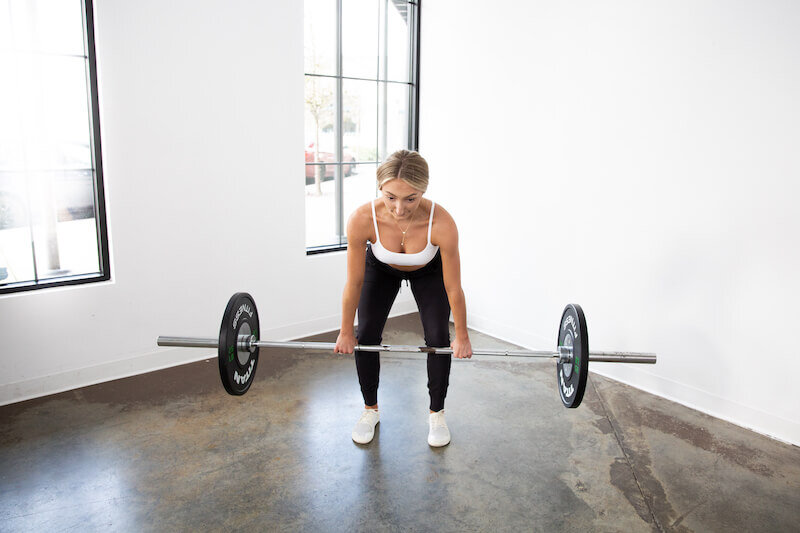You’ve seen that person at the gym. They walk in, set their keys down and hop onto a machine. Maybe it’s the leg press or even the bench press, and they swing their arms and legs, wiggle around for about 30 seconds, then start loading on plates.
That is not a warm up. Believe me when I tell you, four years ago, I was that person. I would skip a warm up. Before I knew anything about the human body, preventing injuries, I would roll into the gym and be like “Yep, I’m warm.”
But… the reality is, it wasn’t really doing me any favors.
You need to warm up before exercise because it’s prepping your body for the exercise you are about to perform and it also can reduce your risk of injury by increasing your muscle’s dynamics (Woods et Al, 2007).
Okay, so now that you’re convinced a warm up is important, let’s dive into what makes a good warm up routine.
What Makes a Solid Warm Up Routine
Identify Training Goal or Intention
When deciding what you are going to include in your warm up, first determine what the session includes. Are you squatting, running or bench pressing? Doing a specific warm up is beneficial because it mimics the movements you are going to perform.
Light Aerobic Activity
Continue your warm up with 3-5 Minutes of light aerobic activity. Walking on a treadmill, or using a bike works fine here.
Dynamic Stretching
Perform dynamic movements that have something to do with the exercises you are about to perform. “Dynamic stretching involves active tightening of muscles to move joints through their full range of motion. Functional and sport-specific movements help increase muscle temperature and decrease muscle stiffness” (Stretching Tips for Athletes).
For example, on a squat day, some dynamic stretches you could include are leg swings, holding a deep goblet squat for 20-30 seconds (adding a dumbbell or plate for resistance), the world’s greatest stretch, or walking lunges with an upper body torso twist. Once you’ve done a couple of these you should feel your heart rate increasing a little and the muscles waking up.
Muscle Activation Exercises
No matter what lift you’re performing, activate your core muscles. I like to use stability ball dead bugs, side planks, pallof presses or bear crawls. I continue by activating the muscles that are going to used in the lift. Personally, I know I have a weak glute medius so I pay close attention to priming my glutes for a squatting or deadlifting day. I’ll do some banded exercises to get my glutes recruited for squatting. Exercises like banded lateral walks (2 sets of 15-20 reps on each side) or side plank clam shells are great for activating the glutes for the squat. I’ll even add in some banded glute bridges just to make sure my glutes are ready to go.
Lightweight Movement
At this point, it’s been about 15 minutes and you should be ready to get under a barbell. Here you should perform a lightweight version of the movement pattern you are performing. Begin with an empty barbell, maybe something lighter if you’re a beginner. We are still in the warm up phase, so don’t pile on the plates just yet. When performing these warm up movements under the barbell perform 2 sets of 10-15 intentional reps. Although the weight may be light, focus on your form, the barbell position on your back, breathing and getting the body ready for some heavy squats.
Load Up
After two sets, I start loading on plates. I don’t just jump into a PR though. The current program I’m working through is for strength so I work gradually up to my max weight. Taking into consideration how I feel each time I add more weight. I write my weights down, how it feels, how it looked (I film most of my squats) and then decide if it’s a personal record kind of day (this doesn’t happen every week that I lift). Then once I’ve hit my highest rep, I perform three more sets at 85% of my max.
This is a total of 6 sets of 5. 3 sets of 5 working up to my weight, then 3 sets of 5 at 85% of my max. Yes, it’s a lot of squats. But it feels damn good because I really took the time to warm up.
Overview of a Warm up:
- Identify training goal
- Get heart rate up with at least 3 minutes of low impact cardio
- Perform specific dynamic stretches
- Activate muscles being used in your big lift/prime your core
- Perform body weight movements of lift or be begin very light barbell work, taking note of how the movement is feeling
- Load up the barbell
Sometimes, you only have 45 minutes to lift. On these days, your warm up may be a little shorter. However, knowing where your weaknesses are, what your training objective is for the day, you can pick and choose what exercises or dynamic stretches you need. Start doing a proper warm up and you will get more out of your sessions and be less likely to injure yourself. Lifting weights is complex. Your body isn’t unbreakable, so make sure you take care of yourself by warming up.
Feel free to leave a comment or question below and as always thank you for reading 🙂
References
“Stretching Tips for Athletes: Dynamic and Static Stretching.” Hospital for Special Surgery, www.hss.edu/conditions_stretching-tips-athletes-dynamic-static.asp
Woods, Krista, et al. “Warm-Up and Stretching in the Prevention of Muscular Injury.” Sports Medicine, vol. 37, no. 12, 2007, pp. 1089–1099., doi:10.2165/00007256-200737120-00006






